Last Updated on May 1, 2023 by asoulwindow
Table of Contents
What is the Nocte tribe?
The Noctes are the easternmost inhabitants of India who I met during a road trip to Longding and Tirap circuit of Arunachal Pradesh. Noctes are essentially simple village folks with more color and unique culture. Not many know about this lesser-known headhunting tribes in India.
I noticed that the Nocte people are not very tall, have sharp mongoloid facial features and are well-built with medium structure.
There are 3 major tribes which call the Tirap district in Arunachal Pradesh as home at present. These tribes are distributed across various parts of Tirap. Here are the three main tribes of Tirap and the places they occupy:
- The Nocte Tribe: Lives in North Tirap
- The Wancho Tribe: Lives in South and South-West Tirap
- The Tutsa Tribe: Lives in East Tirap (Changlang and Khimiyong circles)
What tribe were head hunters? Who are the headhunters of North East? Who are the headhunters of Arunachal Pradesh? These are some commonly asked questions. The Noctes and Wanchos were fierce headhunters of Arunachal Pradesh along with the more famous Konyaks of Nagaland.

Nocte tribe headhunter
What does headhunter mean in tribes? Who are known as head hunters? Nocte tribe history is very interesting.Not many know about the age-old tradition of headhunting in Arunachal Pradesh of North East India. Headhunting is an important feature of the Nocte tribe. In those days, headhunting enjoyed religious sanctions. Headhunting used to be practiced only after divination. It symbolized manliness and power in those days! The Nocte homeland trails in Tirap district left me speechless!
Why was headhunting practiced by Nocte tribe in Arunachal Pradesh? One of the main reasons for headhunting, I was told were the internal feuds between villages due to several reasons. As per some accounts, headhunting was first practiced by Noctes and later adapted by the Wanchos. In some cases, one village challenged the other and it led to headhunting. Encroachment in other’s territory was also a trigger point.
Even petty issues such as cattle entering the land of a different village led to headhunting. The fierce Nocte warriors didn’t spare the British too during the colonial era. The enemy villages were raided either by ambushing or stealthily.
What is the history of headhunting? Once the headhunting expedition was successful, the entire village used to gather together and celebrate the win with dance and songs. There was a certain process followed strictly by the elders. The human heads which the winning team brings back to the village were collected together. The head priest of the village would sprinkle a mix of eggs and powdered rice on the heads. This was done to calm the energy and spirits of the deceased. After this process was over, heads were hung on the trees to dry.
The men who committed headhunting, applied tattoos all over their bodies, especially the chest. I saw many such elderly tattooed men during my visit. Later, the heads were cleaned, boiled and collected together during Khotang festival. A dance around the heads and a lavish community feast completed the ceremony.
In fact, community feast was also shared with the heads. Once all the Khotang festivities got over, the heads were kept at its final resting place, i.e. the morungs. This is how the young boys learnt about the exploits of their elders and the ropes of headhunting.
I saw basket full of fragments of skulls, including that of the British in a morung in Kheti village. Lapnan and Kheti are the only villages where you can see human skulls on display in morungs even today. The human skulls in other places were buried or burnt by the locals under the influence of Christian missionaries.
When was headhunting banned in India? When did the head hunting stop in Arunachal Pradesh? These are some commonly asked questions. The last headhunting was reported in the year 1991. Is headhunting still practiced today? No, the younger Nocte generation have never experienced headhunting.
Upper Nocte Tribe
Upper Nocte and other Nocte are same except for few differences. Upper Nocte people are known for their art and craftmanship, my guide, who is also a Nocte, told me. Highly skilled in crafts, I saw some of their work in the Laho and Moktowa village which is counted as Upper Nocte Territory. Upper Nocte live on higher grounds in hilly areas.
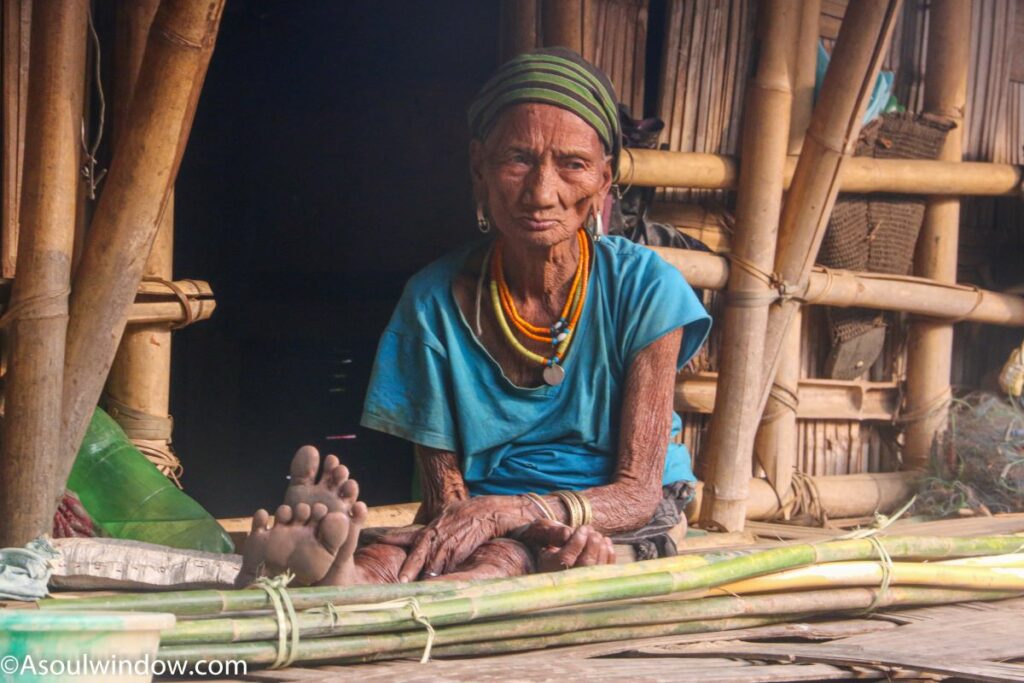
A unique feature which I noticed was that the Noctes decorate bamboo stick with goat hair. Their bamboo and cane works are well known. I saw an upper Nocte man making a basket in Laho village. Noctes are deft at making different varieties of baskets. Much of the artwork I saw in the home of the King of Laho spoke volumes about their fine artistic workmanships.
Ollo Nocte Tribe
Members of Ollo Nocte tribe are mostly found in Lazo circle of Tirap district of Arunachal Pradesh. Ollo people are also known as Oloh or Lazu Naga.
Lazu village which I visited is one of the biggest villages where a majority of Ollo Nocte people live. This is where I met most of the Ollo Nocte people. Ollo people also live in Naga self-administered zone of Myanmar. On the Burmese side, there are many villages where Ollo Nocte people still live.
The Ollo Noctes are distributed across 12 villages under Lazu circle in Tirap district such as Raho. The Ollo people are considered as a subgroup of ethnic Nocte people at present. It may change later after the Arunachal Pradesh Government gives them official recognition. Since the Ollo people have centuries old unique traditions, rituals, culture and a distinct language, the demand for recognition as an independent community have risen recently. The Ollo people do tattoo on face while the Nocte people do tattoo on hands and back.

Nocte is a tribe of which state?
The Noctes are the easternmost inhabitants of huge nation of India. Members of Nocte Tribe calls the Patkai hills of Tirap district of Arunachal Pradesh, India as home.
My Experience of meeting Nocte tribe
I visited several Nocte villages during my 8 days long trip across Longding and Tirap district of Arunachal Pradesh. One of the most interesting and biggest Nocte villages I visited was Lazo near Khonsa. I met an old lady with tattoo and pierced ear plug in her home. She lived alone in that big bamboo house while rest of her family lived in nearby big town Khonsa.
Kheti Village: Skulls from headhunting days
I had also visited the Kheti Village near Khonsa. Kheti is a pretty big Nocte village with immense historical importance. While Kheti is known for a morung which still houses human skulls, ‘won’ by the headhunters, it is also known for being the last village to give up the ancient burial practices of the members of the Nocte tribe. Apart from the Kheti village, the nearby Lapnan is the only other Nocte village where you can still see human skull trophies won during headhunting days. The memories of the bloody deeds of their forefathers have left many younger Noctes speechless.

Kheti village is also the site of Anglo-Nocte Conflict of 1842. The Anglo-Nocte Conflict of 1842 is as an important part of the Indian freedom struggle from Arunachal Pradesh. In November 1842, the Noctes residents of the Kheti village attacked an armed British expedition team led by Captain J. Brodie, the Political Agent of Sibsagar, advancing towards their village.
It was a fierce battle, as a result of which, the Britishers had lost two soldiers and four of their army men were badly injured. This forced the Britishers to retreat. However, they returned back for revenge. Barely a month had passed, when in December 1842, the British launched a punitive expedition against the unsuspecting Nocte people in this part of Arunachal Pradesh.
Insulted by their defeat by the Noctes, this time, the Britishers came with a greater force. Captain S.F. Hannay, Commander of the Assam Light Infantry Battalion; Lieutenant Rowlatt of the 2nd Sebundies and Lieutenant Reid of the Local Artillery Company had joined Captain Brodie.
Due to the sheer size of the British force, their modern arms and artilleries and their preparedness, the Nocte people were caught unawares. Needless to say, the Noctes failed to win the battle despite defending themselves with all their force. This also reminded me of the Khonoma battle of Nagaland.
Since the Noctes failed to push back the Britishers, it emboldened the latter. The advancing British force mercilessly burned down Kheti village. It was easy to burn an entire village because all the buildings and structures in Kheti are made up of wood, cane, Toku palm leaves and bamboo. As a result, the inhabitants fled to other nearby locations.

The punitive expedition continued for a week and the Britishers used every means to induce the submission of the members of the Nocte tribe, but didn’t get much success. Since they failed to pursue the Noctes any further, the Britishers returned. MLA from Borduria, Shri Wanglin Lowangdong had also mentioned about the Anglo-Nocte Conflict of 1842 in his speech during the assembly session.
Soul Window Connections
What is the history of headhunting? I was surprised to see that Kheti Village and Lapnan village still have some of the human skulls the headhunters hunted, displayed in a fashion similar to what you have seen in Killing Fields of Choeung Ek, Phnom Penh in Cambodia or Cemetery of Fontanelle of Naples in Italy, Europe. In old times, the tradition of displaying the skulls of the dead men in the morungs or dormitories was also very common. However, it is discouraged now. Not that many skulls are around anyways.
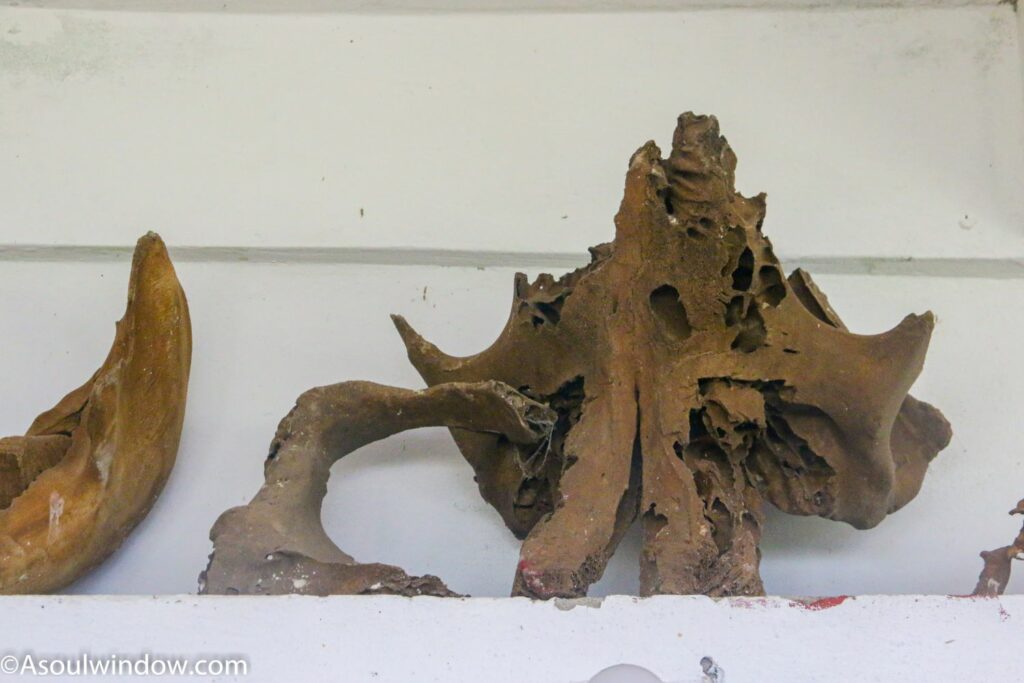
The Noctes were always smart and capable people. Noctes indeed are the unsung heroes of Arunachal Pradesh. Such incidents are lost and unknown to not only the outside world but also to the younger Noctes. In fact, there were many such incidents where clashes between the Noctes and the Britishers had been observed during the Raj. Most of these clashes were aimed at containing the British advancements. We know of these accounts from the elder Noctes and the written accounts of the British.
I had also met Shri Nepha Wangsa in his home in the nearby Ngissa. He has written a book on the Wancho Anglo War of 1875.You can learn more about the Nyinu Massacre on my blog on the Wancho tribes.
Holy Place of Noctes
We also visited the holy place of the Nocte people in Kheti Village. I saw two naturally formed stone structures placed on a large round platform overlooking the green valley. It was centuries old stone, I was told. Mr. Ngampay Lamaty who is a public leader affiliated with PPA or People’s Party of Arunachal shared great insights with me. Twice in a year, in April and July, people congregate in a festival and each house offers clothes, chickens at this place of worship. The head of the village performs the rituals. Females are not allowed to participate in the rituals. Arunachal Government has also recognized the deity.
During headhunting times, the deities were brought here from a higher hill. The female figure and child figure of the deities are at the platform at present. The male form is still located somewhere higher on the hills. The deities of Kheti village are known as Avi Longtumwang or Evi Longtumwang.

The deities are mostly worshipped by the people of Kheti village only. Mr. Ngampay compared the stone idols with the largest naturally formed Shivling in the world worshipped in Ziro, also in Arunachal Pradesh.
Laho village: Upper Nocte
By keeping the polyglot Khonsa town as our base, we made a day trip to Laho village. It lies in the Upper Nocte Territory. Driving on the dusty roads of this part of Arunachal Pradesh, we passed the ‘Welcome to Dadam’ gate. A statue of Jesus Christ with his arms stretching out, right next to the gate added to our welcome ceremony. We passed through beautiful views of the hills which practice Jhum Cultivation.
Here we met the King of Laho in his traditional home made up of bamboo, wood and cane. The first thing I noticed in this house on stilts was the beautifully carved ladder to the home. Genuinely, there is also a back entry here, which requires no ladder to enter the home. Right next to the ladder, two huge sculptures of tigers carved on a large and dark wooden panel welcomed us. Another large wooden sculpture shows the King holding the tail of the tiger. The local Noctes believe that the King has the soul of a tiger.
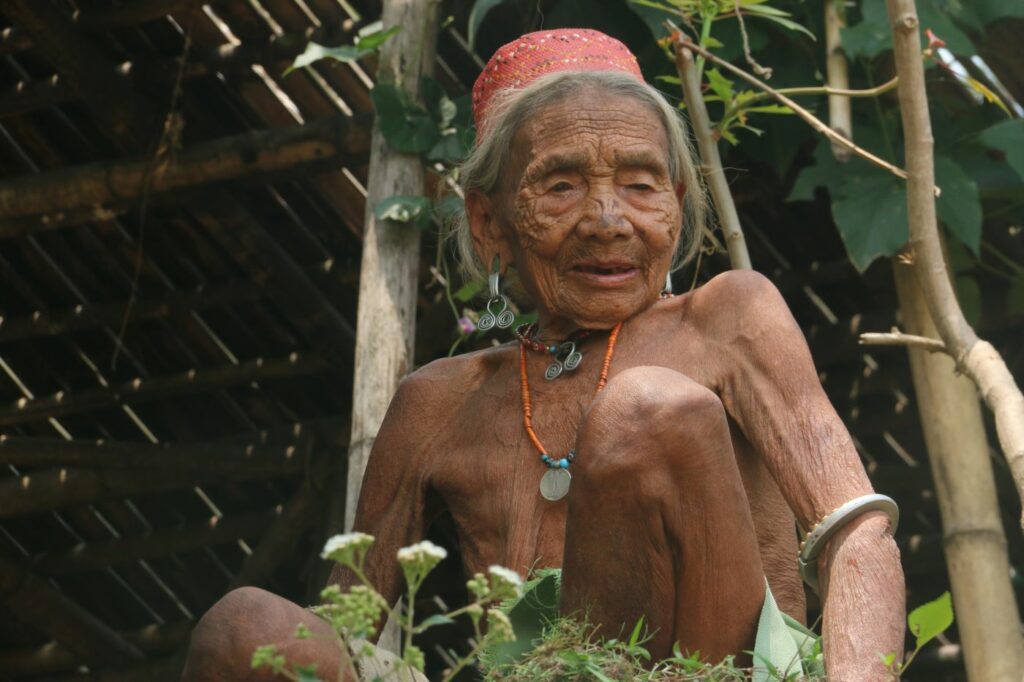
I knew I was at King’s home. No other house in Laho boasted of such architecture brilliance. The house was built on the highest hill, as if watching over the entire Laho village. A small uphill walk brought me here. My guide asked me to notice the floor pattern of the house of the King. The criss-cross weaving pattern is allowed only in the house of the King.
This house was the perfect example of vernacular architecture. Every 10-15 years they renew their house. I walked past several beautiful wooden sculptures, millet left for drying, trophies and family photographs as I explored every inch of the home of King of Laho.
Lazu Village: Ollo Nocte Tribe
Our last stop on this week-long trip across Tirap and Longding district was Lazu village. I was amazed at how large this village was. I was told that Lazu is in fact the biggest of all the Ollo Nocte tribe villages. The small urban set up of Lazu also caters to the everyday needs of the several villages of Myanmar located along the international border and Lazu area. In fact, many marriages between the people of Myanmar and India is also common.
Spread across hills, this village located close to India-Myanmar border turned out to be a revelation. Populated with the Ollo Nocte tribes, who have a distinct character, visiting this place left us with new insights. I visited morungs, home of the King as well as homes of the common people. Lazu is a must-visit village in Arunachal Pradesh.
What sets the women of Lazu village apart is that the women here also apply tattoos and shave their heads. I met an oldy lady with tattoos, a large piercing in her ears and shaved head, right in her home. We missed the folk-dance performance by the locals during the Woraang festival by few days.

What makes the Nocte Tribe so famous?
The unique practices, unusual customs, a rich history, colorful costumes and festivals have put the spotlight back on the Nocte people. Discerning travelers and scholars make extra effort to immerse in the Nocte culture by paying them a visit in their own village. The similar cultures with the Konyaks of Nagaland and the same headhunting spirit makes the Noctes famous.
Soul Window Observations
Shri Bhupen Hazarika of Assam has also mentioned about the Nocte tribes and Tirap district in his song Tirap Simanta Rupor Nai Anta from the 1966 movie Lotighoti. The song also mentions Wancho people way back when no one out of North East knew them. But then, do people know about Wanchos and Noctes even now? I hope this complete guide on lesser-known tribes of Arunahal Pradesh will change that!
Nomenclature of Nocte people
Not many are aware that, in old days, there were no separate names for the local tribes of Arunachal Pradesh. It was as recently as the 1950s when the term Nocte was coined to address this community.
The literal meaning of Nocte is villager or village people. While Nok means village, tey stands for people. Nocte people are also called as the Nocte Naga.
During the reign of the Ahom dynasty in the neighboring Assam, The Nocte people were known as:
- Bor Duris
- Borduaria
- Paniduaria
- Namsangia
- Namsangya
The above names given by Ahom people varied according to the location of the Nocte village. During the British rule in India and in the medieval era the members of Nocte tribe were also known as Naga people or Noga, mostly due to their close ethnic relations with the Naga people who still live in what is now known as Nagaland.
Jhum Cultivation of Nocte tribe
I saw many wooden huts across the terraced fields. Sensing my curiosity, my local tour guide told me that the huts are built so that the farmers can take rest while they work in the fields. No one stays in these huts overnight. However, the huts help the farmers in finding shelter and a place to eat lunch and take rest.
Millet, ginger, tapioca. After harvesting millet, they also grow several varieties of rice such as the local red rice on these fields. After rice is harvested, the residue is burnt and the field is allowed to recuperate and regrow till 7-8 years. During this time, the farming is done on another land. This is why, jhum cultivation is also known as shifting cultivation or slash and burn cultivation. It improves the health of the soil. Jhum cultivation is a centuries old practice popular in the hilly North East Indian states such as Arunachal Pradesh, Mizoram, Nagaland and neighboring Chittagong hill tracts of Bangladesh.

These days, people are looking for more sustainable alternative to jhum cultivation because as per some scientists it leads to soil erosion, reduction of soil quality, destruction of wildlife habitat, loss of biodiversity, loss of soil fertility, deforestation and even flooding of water bodies such as rivers and lakes. The ash is also seen as a pollutant to nearby water bodies. At present, in India, jhum cultivation is popular in hilly north east Indian states of Arunachal Pradesh, Nagaland and Mizoram. Mostly, the burning begins in May and June.
Nocte Tribe Music and dance
If you want to see the best display of the song, music and dance practiced by Nocte people, then you must attend one of their festivals. This is when they dress up in their sartorial best too. It is a treat to watch the Noctes celebrate their festivals with rhythmic dance and haunting music.
Nocte tribe ethnicity
Nocte people belong to the Tibeto-Burmese ethnic group. Ethnically, the Noctes are related to the Konyak Nagas of the adjoining Indian state Nagaland.
Origin of Nocte tribe
Nocte people have Burmese roots. The origins of Nocte people can be traced back to the Hukong Valley in Myanmar. Itis estimated by several historians that the Noctesmigrated from the Hukong Valley in Myanmar between the years 1670 and 1700 C.E. It is said that the pleasant climate of the Patkai Hills and highland salt attracted the Noctes from the then Burma. Temperate and lush subtropical vegetation of the Patkai Hills even tempted me to relocate!
What is the occupation of Nocte tribe?
Off late, a lot of focus is being shifted to agriculture, horticulture and veterinary activities for sustainable and permanent economic stability. In villages like Lazu, opium cultivation and addiction are being discouraged by the politicians. They are rather encouraged to grow cash crops for a sustainable future.
The Noctes are essentially subsistence farmers. However, the younger generation is increasingly leaving their tribal homelands and moving to bigger cities such as Itanagar, Khonsa, Guwahati, Dibrugarh, Delhi, Mumbai, Bengaluru in search of opportunities and a modern lifestyle.
What is Nocte language of Arunachal Pradesh?
What language do the Nocte headhunters of Arunachal Pradesh speak? Nocte is the language spoken by the Nocte tribe. Nocte slightly differs from Wanchos linguistically. However, when it comes to traditions and cultures, they are quite similar. Noctes used to speak Sino-Tibetan languages earlier. The nocte language also differs. For example, the dialects spoken by people of Chasa is different from the dialect of Paniduria, from where my guide belonged to.
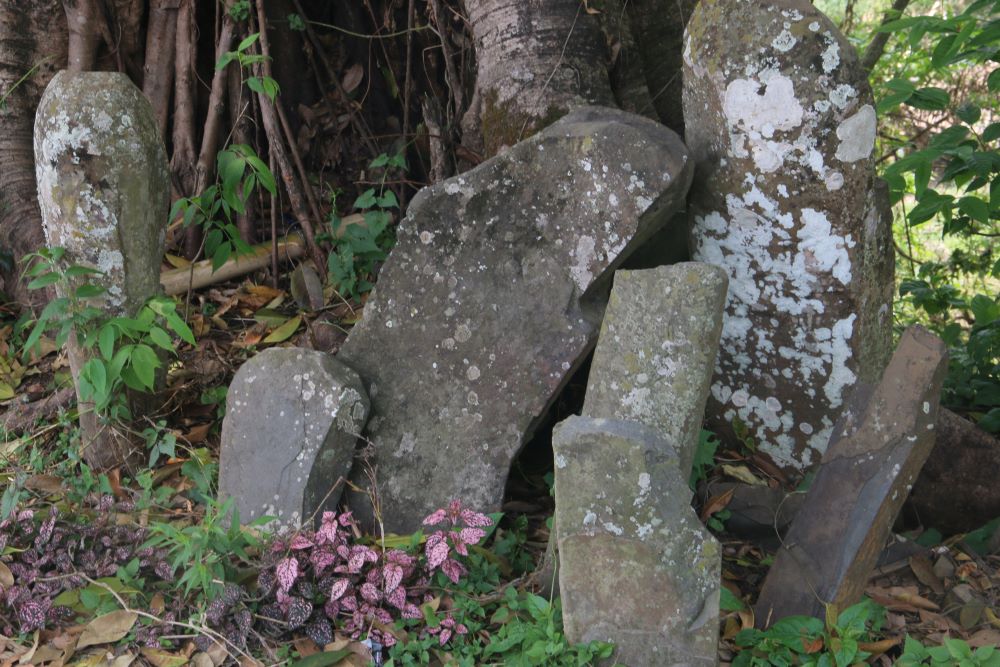
Religion of Nocte people
What religion were the head hunters of Arunachal Pradesh India? What is the religion of the Nocte tribe? These are some frequently asked questions. The Noctes have diverse faiths. For example, some Noctes follow animism, Christianity or even Theravada Buddhism which I also noticed in Sri Lanka. However, under the influence of Shri Shankardeva, Noctes have also adopted Hinduism since early 18th century.
Here is a complete guide:
Animism
Long ago, when the Noctes had migrated from Burma, they used to practice animism. Their indigenous faith is still practiced at some Nocte homes. Originally, the Noctes worshipped Jauban or the supreme God and other deities. Food and water was offered to the Gods by Noctes with the goals to appease them. Despite conversion to Hinduism and Christianity in the later years, many features of the animistic roots of the Noctes still survive and are practiced to this date in their homes.
Hindu past
I was surprised to know about the Hindu past of the Nocte people. Did you know that the last King of united Namsang, Borduria and other Nocte villages under the Ang of Namsang and Ang of Borduria practiced Hindu faith? In later years, the Noctes started to trade salt with the people of the next-door Hindu majority population of the Assamese plains. Not only did it result in a cultural exchange, but some Noctes also learned to speak, read and write the Assamese languages. Over the years, many Noctes converted to Hinduism.
In the early 18th century C.E., precisely in the year 1717, Lotha Khunbao, the Chief of the united Noctes, was named as Narottam after he became a Vaishnavite. Narottam means the best among men. He was conferred with this title after his spiritual enlightenment.
He accepted tenets of Vaishnavism after he dreamt of his spiritual teacher, Shri Ram of the Bali Satra, instructing him to release two bamboo tubes -filled with silver and gold- in the river, which will ultimately lead him to his Guru.
Christianity
Recently several Nocte people began converting into Christianity under the guidance of Christian missionary Miles Bronson. His sole purpose to come to this region as well as Myanmar and China was conversion to Christianity.
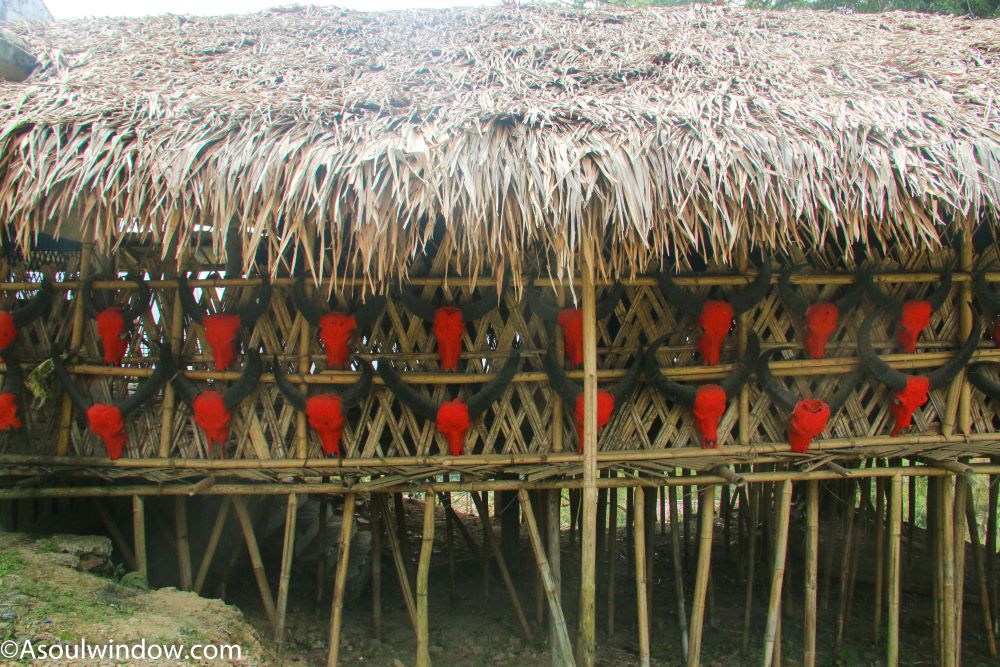
The Nocte King
The Noctes have a very systematic administration of their villages. The social life of the Nocte people is classified into 2 classes or groups which includes:
- The chief or the king and
- His kingsmen or commoners
This practice separates the Noctes from the other tribes who live in Tirap. The local elected chief of the Nocte village is known as Ang. I remember, it was the same case when I visited the home of the Ang in Longwa near Mon in Nagaland. The chief is also known as Borduria or Namsang. The job of the King is to protect and keep the law and order of the village in place. The King also receives tributes.
With the support of his council known as the Ngoang-Wang or Ngoangthun village council, the local King exercises control over his village. During my visit to the Longding and Tirap tourist circuits, I explored several Nocte villages and met the local Kings or chiefs.
During significant social, festive or religious occasions (and in old days, war-like situations), The King is supposed to consult with the local priest, other elder members of the village and lowang-tang or trusted family. Final decision making is done by the King. This practice is still in use, I was told.
Polygamy in Noctes
The Noctes practice polygamy much like the Wanchos, Konyaks and other Tibeto-Burmese indigenous ethnic tribes of North East India. When I visited the King of Laho village, he told us that polygamy in Nocte society is often misunderstood by the outside world. In old days, Kings used to marry many women, so that the other women help him run the home and divide the work.
Being a King, he has a lot on his plate which is not possible to manage alone or with just one wife. The Kings used to have 3,4,10 or even 25 wives in earlier days. However, the numbers are declining these days though polygamy is still practiced and common.
I was told that the main queen doesn’t do any household chores. Household chores such as cooking, cleaning and serving guests are taken care of by other queens. In case the main queen dies then the next queen takes her position and perks.
Nocte tribe culture and tradition
The Noctes shares many features of the Konyak tribes I had met in Nagaland many times. Some of the cultural similarities between the Noctes and Konyaks are tattooing the body and the practice of headhunting.

Nocte tattoo
In old days, both men and women used to wear tattoos all over their body. However, the new generation of Noctes is shying away from this centuries old tradition. When I visited Lazu, occupied by mostly Ollo Nocte people, I noticed an old day with tattoos across her body, including her face. Black lines ran through her forehead to nose. Even her cheeks, arms, legs and abdomen were tattooed. She turned out to be one of the last of the women in the villages surrounding Lazu Town who still have tattoos on her body. She was bald and wore traditional jewelries. I was amused to see her wear a necklace with old Rs 2 Indian coins in it. The ones which had face of deceased politician Rajiv Gandhi and others. Her unusual bangles and metal ring also stood out. She looked gorgeous!
I was not able to figure out the true meaning behind her tattoos. Not many could explain to me the meaning behind the pattern of the tattoos. I inquired deeper and got some interesting viewpoints. My guide said that in old days, tattoos were a requirement for marriage. In fact, people from the Ollo community used to looked down upon women who used to marry without a tattoo. Tattoos were therefore a symbol of status for the Ollo people. After the tattoo is done, the person also has to give a big feast to the other people in community.
A local Ollo Nocte man with an Uighur like beard told me that in old days, British used to pick local girls, so to discourage them, the women used to tattoo their faces.
My guide told me that the Ollo Nocte people believe in afterlife where their grandparents and departed ancestors have already reached. Therefore, tattoos help their ancestors to recognize them in afterlife.
While men in Ollo tribe used to tattoo their body to mark their exploits in a war, the women tattooed themselves to enhance their beauty or to continue the tradition. The practice of men tattooing their body died out after headhunting was banned and people moved away from wars and battles.
Stretched ear lobes
The same old lady had traditional large pierced ear lobes. Her earring holes were stretched to accommodate a large ring and even small flowers. This was done to beautify her looks. The Ollo Nocte women, in old days, greatly enlarge their ear lobes and wore rounded wooden pegs. The ears are pierced right after few days of the birth of girl child. A ring is placed in the pierced area to expand the skin.
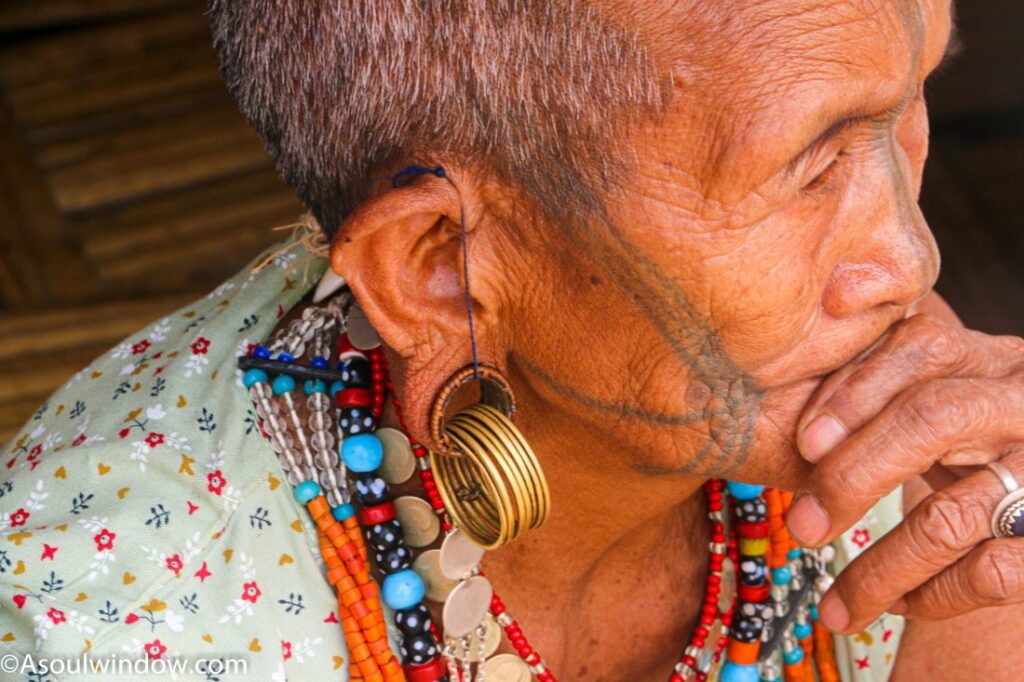
The old lady I met wore ring in one ear and flower in other. My guide told me it was a practise to beautify them and attract opposite sex. This was the first time I met people who practise stretching their ear lobes. Interestingly, I have observed that the similar practises are also observed in some African tribes and closer home, Odisha.
Nocte tribe food
While the Nocte people are mostly heavy meat eaters, I was more intrigued with the green things they filled their faces with. To my surprise, Nocte do include lot of fresh fruits and vegetables in their daily meals. Being expert agriculturalists, the Noctes grow several crops such as rice, tapioca, maize, fresh assorted vegetables, leafy green vegetables.
Some local vegetarian and vegan food of Nocte people I enjoyed was the spicy mashed banana flower and millet wrapped in banana leaf. Since I was vegetarian, arrangements were made for me. I also had paneer, dal, rice, green leafy vegetables and alu bhujia on a daily basis throughout the trip.
Not surprisingly, the famous Bhoot Jolokia is commonly available across Arunachal Pradesh as well. Not many know that Bhoot Jholokiais actually an Assamese name.Bhoot stands for ghost while Jolokia means chilies. In Nagaland, they call it Raja Mircha while people of Arunachal Pradesh know it as Mithun/Hathi mircha. In the Nocte language, it is known as Puok Richit where Puok means elephant and Richit means chilly.
Soul Window Tips
Bhoot Jolokia is so spicy that just a small bite can leave a burning sensation for hours. I once had a miniscule overdose of it, followed by a stomach burn. I googled the cure and figured out that a simple bowl of curd can calm the stomach (and the soul!) It did!
I also tasted Jabrang pepper in a home of Lazo village, which is a local alternative of black pepper. Also known as Sichuan Pepper, it is widely used in homes of Arunachal Pradesh, Meghalaya, Assam etc. In Assamese, it is known as Mejenga. Khasis of Meghalaya call it Jayur. There are several varieties of Jabrang and each of them has different pungency and smell. I tasted just one Jabrang in its raw form and it left a long-lasting characteristic tongue numbing/tingling sensation.
I also tasted a sour berry known as Janu. It is a native fruit. The Assamese call it as Noga Tenga which means sour fruit of Naga people. Tenga means sour and Noga means Naga. It was so sour, I could not finish even one, but my co traveler Geethu loved it. She asked me to try it with salt and chillies. I dared not try it. Some people make drinks out of it in summer, while some dry it and pickle it with salt, turmeric, chilies and mustard oil.

We tried the green ones. It is reddish when fully ripe. It is easily found in Arunachal Pradesh and Upper Assam in places such as Jorhat, Sivasagar and Dibrugarh. Noga Tenga is a lesser-known edible fruits of North Eastern India. Scientific Name of Noga Tenga is Morella rubra. Family/Families: Myricaceae.
We also saw a couple carry local variety of ginger on the conical bamboo baskets tied to their back as we drove to Laho village from Khonsa. It was larger in size and oddly shaped. It is locally known as Chinyong. Chinmeansginger and yong means big.It is an indigenous variety of ginger.

Nocte Tribe Beverages
I also tasted Jumin at several Nocte homes. ‘Jumin’ a traditional alcoholic beverage of the Nocte tribe. It is easy to find Jumin in the homes of Nocte people and on festivals. Jumin is a fermented beverage which is prepared with Aahu dhan or glutinous rice. I found the taste of Jumin to be sweet-salty-sour, much like fruit juice.
Jumin is first offered to the mother earth and the universe in a ritual called as ramthang or rangtam, only then it is consumed. It has a sweet flavour and muddy white colour. I personally found Jumin to be delicious. You must taste this fermented rice beverage when in the Nocte region. I also tasted a local alcohol of Laho village known as Khambu. It is also similar to Jumin. It looked like Lassi. A local liquor brewed from rice, millet and tapioca is also consumed by the Nocte people.
In recent years lalcha or Lal Chai, the literal meaning of which is the red tea has been commonly consumed in the houses of Nocte tribes. During my travels in Arunachal Pradesh, I found out that it is hard to find the regular milk tea in the homes of local tribes. The famous Masala Tea which the rest of India and some foreigners are so obsessed with has few takers in such remote locations.
What I really enjoyed was a tea at the home of the in laws of Khunwang in Luthong Village near Khonsa town. I enjoyed their ‘Anxie-tea’, the ingredients of which included green tea infused with sweet basil, rose petal and Chamomile. The ‘Immuni-tea’ variety has green tea with orange peel and cinnamon while ‘beau-tea’ has premium quality green tea with pepper mint leaves, cinnamon, black pepper, rose petals, lemongrass, cardamom, ginger and Garcinia cambogia.
The floral and fruity fragrance and the light savory taste of ‘Anxie-tea’ stayed with me for a long time. Very rarely have I tasted teas this flavorsome and fragrant. You can DM them on Instagram. Their handle is Misty.fallvalley on Instagram.
The Nocte Salt
Not many people are aware of the ancient Nocte heritage of salt production and trade with the Hindu Ahom people of Assam and other neighboring tribes. In those days, salt used to be one of the main currencies. So, Noctes used to trade salt with the Ahoms of Assam. Noctes are good at salt manufacturing even now. You can still see ancient Nocte salt-wells known as moransum in the New Subang village (Longrak), also in the Tirap district.
In words of my guide Khunwang who is also a Nocte,
“We have salt springs where the water is salty. In fact, every clan has a common well which has salty water. So, we used to take out water in bamboo. We then split the bamboo and fill it with salt water and keep it under fire for 2-3 days. So, the condensed form yields solid salt. Our salt has a distinct aroma. Its taste is also very unique and good.”
As per Mr. Nepha Wangsa, the author of Nyinu Massacre of 1875,
“Miles Bronson, in March 1839, when he visited Namsang, described that the village is famous for manufacture of salt. It was superior to specimens that he had seen from the salt springs of New-York. Such salt wells are well described in their writings.”
As per Dr. Benjamin Simpson:
“The Namsangya Naga (Noctes) are found in the hill south of Jaipur in Upper Assam near Hukunjuri tea garden and from constant intercourse with the plains are more civilised and better clad than the clans of the interior. They have possession of salt springs, the produce of which enables them to obtain, without much labour, the raiment, ornaments and addition to food which they require.”
Source: Descriptive Ethnology of Bengal (1872)
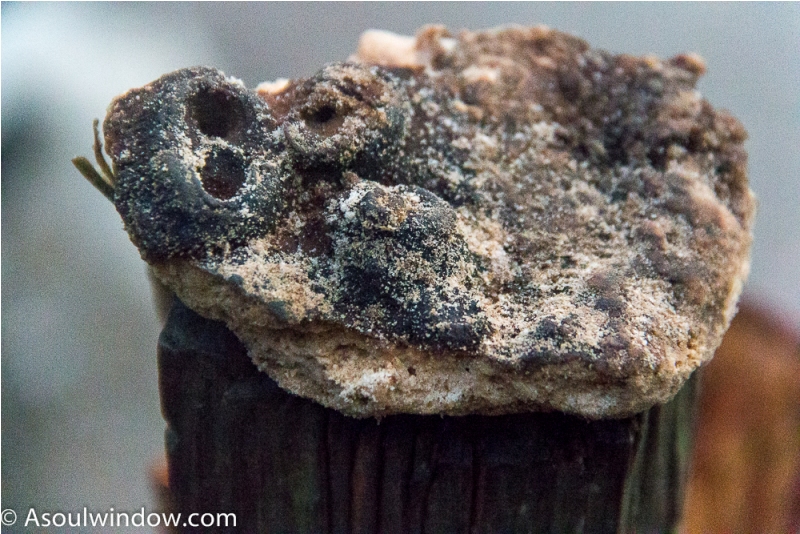
Soul Window Connections
I have tasted similar salts in Bodoland in Assam during the Dwijing festival and also in Ziro. During my visit to the home of the main priest, I have also tasted Tapyo, the herbal salt made by the Apatani tribe in Ziro, also in Arunachal Pradesh.
Nocte Houses
I visited several Nocte homes during my trip to Longding and Tirap circuit of Arunachal Pradesh. Since I visited homes of Kings as well as his subjects, I could clearly see the difference in the architectural styles. The homes of Nocte Kings have a unique flooring done in a criss-cross pattern. This pattern is not allowed in the homes of the commoners.

Also, I noticed several wooden pillars and exquisitely carved massive wooden blocks in the homes of Nocte Kings or Chiefs, which was clearly absent in the homes of the common people of Nocte Villages. Traditionally, the homes of Nocte people are constructed with silts palm leaves, bamboo and cane. However, I did notice few cemented buildings knocking at the door. I may have been looking at the last surviving thatched bamboo huts, built off the land! In some cases, the King also has the privilege to live in a stoneor cement house.
I noticed that the Noctes mostly lived on hill tops to protect themselves from an invading army. Most of the homes are built close to each other in Nocte villages. Thickly populated villages with houses huddles together ensures safety and a community feeling amongst the Noctes.
Nocte Morungs
Whether it was Laho or Lazo near Khonsa town, I noticed several morungs scattered around the village. Lazo was a bigger village with more morungs. In earlier days, morungs were dormitories which sheltered young boys in order to train them to be ‘men’. The elder males teach the young boys about war, folklore, religion and mythology. Morungs also help building a strong foundation of friendship, faith and companionship between the Nocte people. The morung culture is another similarity I saw between the Nocte, Wancho and Konyak tribes.
In modern times, since many Noctes have been converted to Christianity, the Christian teachings are also imparted to them. Some of the dormitories I visited were stilted, which means there was a gap of 4-5 feet between the floor of the dormitory and the ground beneath. It was deftly supported on thick bamboo poles.
The male dormitory is called as ‘Poh’. Each morung, I observed had a huge log drum or thum which was hand-carved with just a machete or dhau. In Lazo village, I noticed that each log drum had a different shape. Some were even colorful and had been given the shape of a tiger on one end. In old days, these log drums were used to announce important matters such as beginning or end of a war.
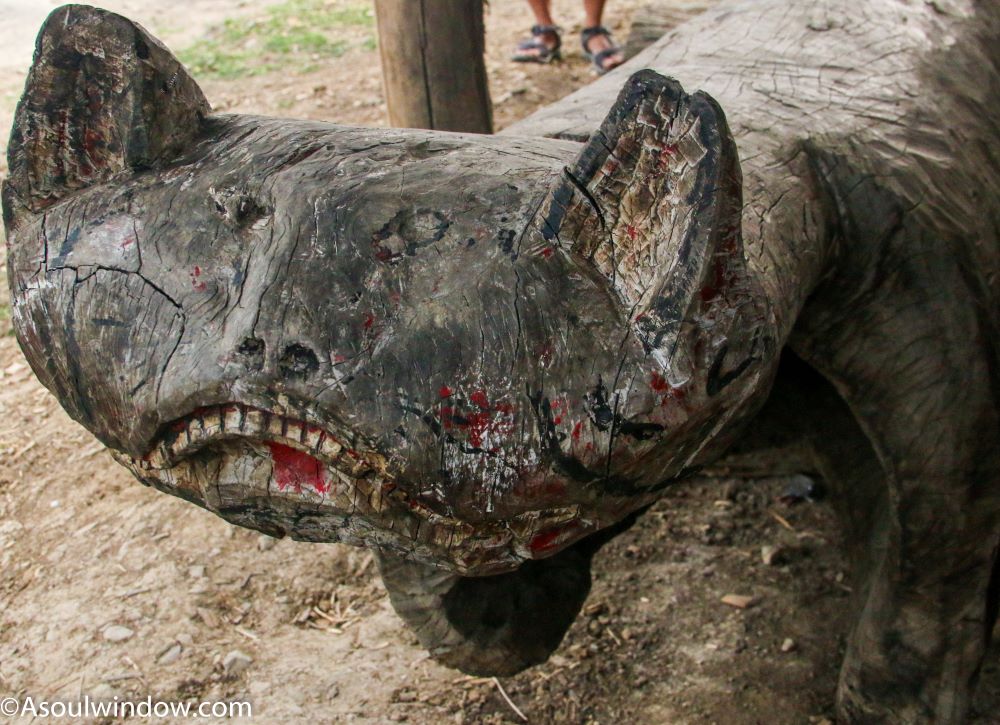
However, I noticed that most of the log drums just gathered dust. Presently, the log drums and morung itself are used only on special occasions such as festivals, rituals etc. In old days, the walls of the male dormitories were embellished with real human skulls which their elders had taken during headhunting. Christianity and western influence have resulted in pulling away the Noctes from their centuries old traditions.
Females are strictly barred from entering a male dormitory. However, it is interesting to note that males can enter female dormitories. The female dormitory is known as Yanpo.
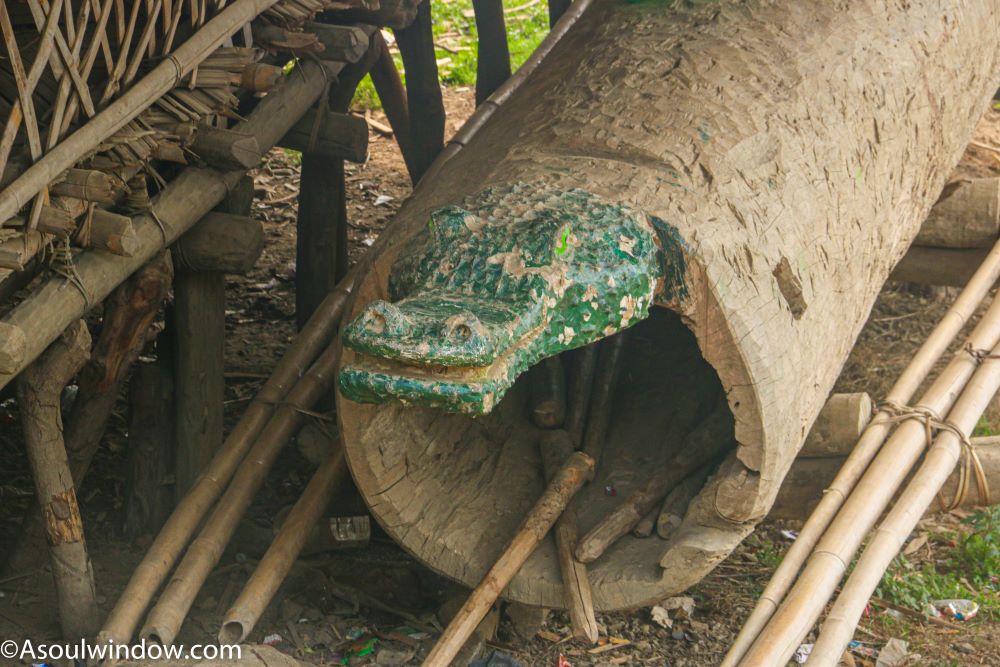
Nocte tribe population
As per the Census 2011, as many as 111,679 Nocte people live in various parts of Arunachal Pradesh and elsewhere. While most people know about the famous Konyaks, not many know about the Wanchos or Nocte tribes of Arunachal Pradesh. This, when the latter are larger in numbers than the Konyaks who live in Nagaland. I feel this may be the case due to Hornbill festival of Kisama and media exposure.
Nocte Tribe Dress
Originally, the Nocte men wore only loincloths while the females wore knee-length skirts. Noctes are also very fond of wearing colourful ornaments and jewelries. I observed that the modern Noctes men, even those living in villages and elderly have abandoned their traditional dresses and wear westernized shirt pants like city people. The women are still the keepers of traditions, but sometimes they can be spotted wearing T shirt with a traditional skirt.
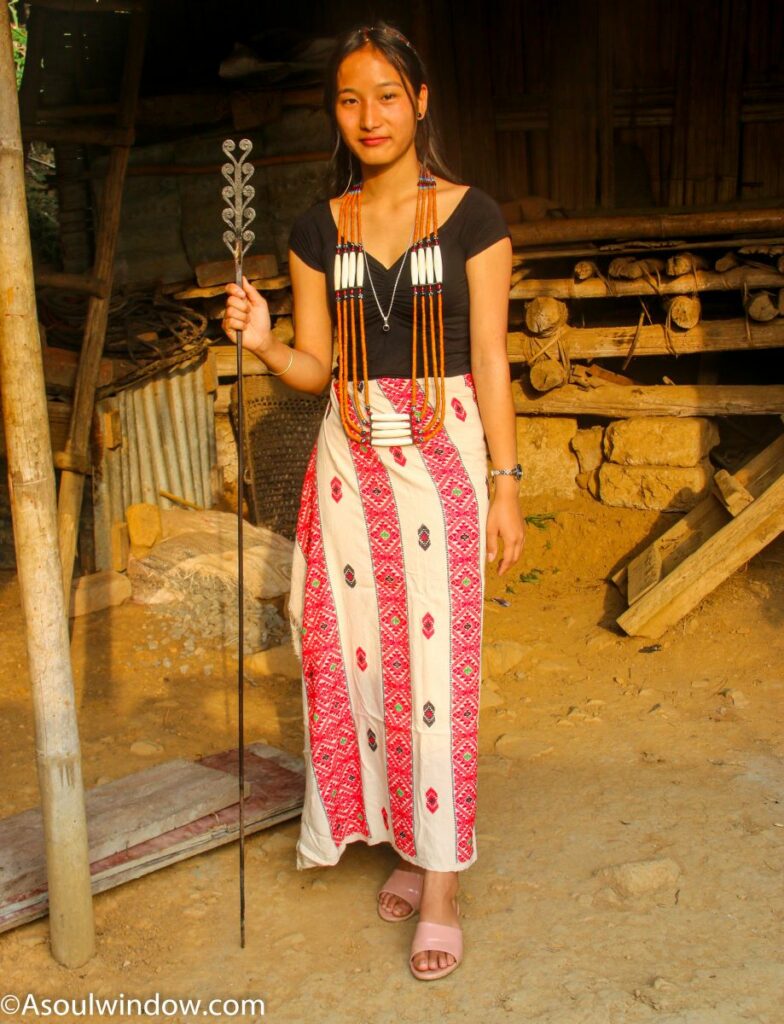
Funeral Rites of Nocte Tribe
In old days, the Noctes used to keep the dead body of their deceased family member out in the open, much like the Tibetans and the Parsis of Mumbai. The bodies were kept around a river. Some Noctes kept the bodies right outside their homes. After Christianity knocked at the door, the Nocte Christians continued to keep the bodies for three days inside their homes. However, since the year 2004, this practice was abolished under the influence of Christianity.
The argument which the Christian missionaries and the reformers gave was that since the bodies tend to quickly rot and decompose, it gets infested with bacteria, germs and insects. This is not good for the physical health of the people who live with the body. The unbearable foul smell was another deterrent. This led to frequent outbreaks of several life-threatening diseases amongst the Nocte people.
The modern Nocte society under the influence of Christian missionaries changed their age-old practice. Ever since 2004, when the old ritual was abolished, the bodies are now given a Christian like burial in coffins. I noticed some of these burial grounds in the Wancho village known as Wakka.
Future of Nocte tribe Community
The disappearance of the knowledge, preserved so proudly by the village elders is inevitable! It is my unsaid fear that in a rapidly changing world, it is so easy to erase the collective memories of an entire community, if not actively preserved. Not only is there an urgency to document all that we can about the local Nocte tribes and others, but we must also tell these stories to create awareness.
I met both old rural Noctes and the urban Noctes who live in cities and I could see the transition already. The younger generation, overwhelmed and enticed by the modern city life and Christianity, have already started distancing themselves from their native roots and culture! While walking across the Lazu village, I noticed more Ollo Nocte woman with tattoo on her face. They were younger, perhaps in their 40s or 50s. In hills, people anyways look younger than their age. My chance meeting with her assured me that the tattoo tradition may still last longer than I expected it to.

Many elders I met had no kids in their home. They were either studying in Itanagar or doing jobs in Delhi, Noida, Bengaluru, Mumbai etc. Some of the modernized tribals I met had a token village home but lived with family in nearest town Khonsa or Itanagar. Some local tribals had taken to beer cans and whiskey over cheaper and heathier local alcohol Jumin.
Soul Window Reflections
With time, new roads and infrastructure have come up, helping remote villages on the Indo-Myanmar border gain access to the modern frills. Is it good for the locals? We in city may sit in our luxury ivory towers and show disdain about concrete buildings replacing wooden houses. But wasn’t all of India like that once? Do they not deserve to live like the city people? Should we keep alive the old traditions for our mere visual delight?
Change is inevitable. The rapidly changing pattern of life is bound to lose some of its old habits, even the favorite ones. As the remote villages become more accessible to the outside world, especially the tourists, external influence is bound to gain ground! Integration has its costs!
Chalo Loku Festival
Celebrated every year during late November, Chalo Loku, also called as just Loku, is the most important annual festival of the Nocte Tribe. Chalo Loku is the main harvest festival of the Noctes celebrated with much fanfare and enthusiasm. Loku means to chase out the old season. In fact, you will be amused to know the meaning of Loku, which is derived from two Nocte words. While Lofe stands for ‘driving out’, Rangku means ‘season’. So, Loku literally means, driving out the season!
It is a great idea to visit the Nocte villagers during the Chalo Loku festival in order to get a deeper insight into the lifestyle of the early Noctes. Some accounts also say the 3 days long agricultural festival of Chalo Loku is celebrated in the month of February. Some of the salient features of Chalo Loku festival include displaying traditional practices, folk dance and music, feasting and even animal sacrifice.
Woraang festival
I almost joined the local people from the Ollo Nocte community in celebrating Woraang Festival at Lazu in Arunachal Pradesh’s Tirap district along the Indo-Myanmar border. When I visited Lazu, the locals were already preparing for the Woraang festival with infectious enthusiasm. The significance of the Woraang festival and mythology is immense. It is a very colorful festival celebrated by Ollo people.
The streets of Lazu were being cleaned, jhalaras made with Toku or palm leaves were being rearranged amidst a visibly festival environment. During the Woraang festival, several rituals are performed by the local people at the makeshift Paang. People from various other villages inhabited by the Ollo Nocte community gather at Lazu and perform local folk dances. The day long celebrations continue from dawn to dusk. A community feast is also organized on the festival day.
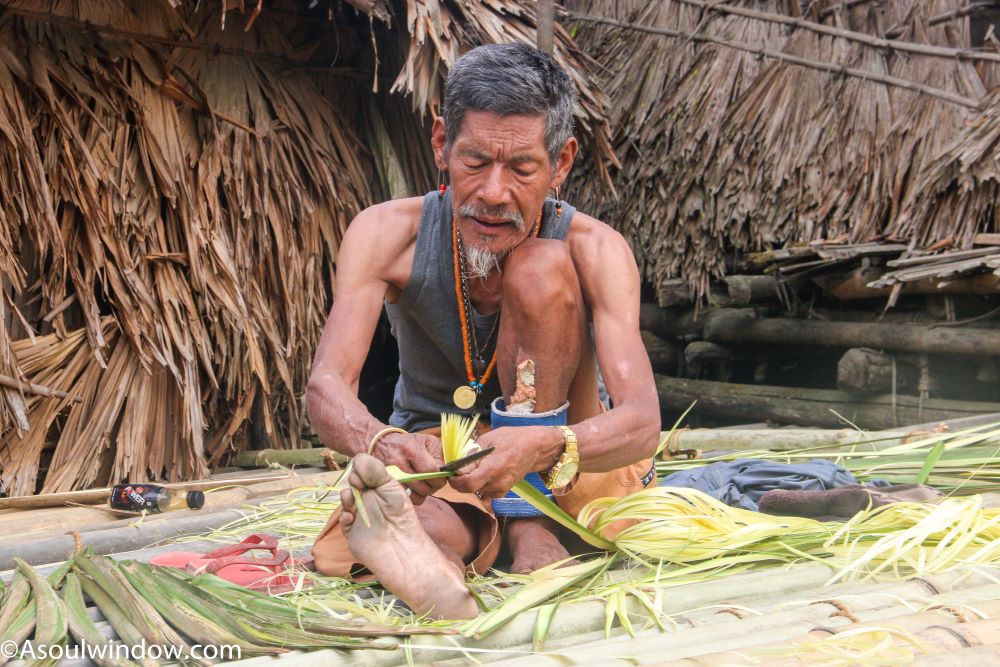
There are around 10 morungs in Lazo village, all of which become the center of attraction during the Woraang festival. The log drums are beaten at each of the morung as part of the festivities. The festival takes place around 15th April and lasts till 20th April. We had missed attending the festival as we had reached 2 days early. Woraang festival is celebrated to mark the bumper harvest.
Hoju Kuwa festival
The people from the upper Nocte Tribe of Dadam Province celebrate a unique festival known as Hoju Kuwa. The Noctes who live in the upper regions of Tirap and Changlang District of Arunachal Pradesh celebrate Hoju. The literal meaning of Hoju is ‘Having Nothing (Famine)’ while ku means sharing and wa means celebration. The festivities begin with the oldest man of Laho or Dadam village offering rangtam (local wine) at the chaam.
My guide told me that in earlier days when famines used to happen in Nocte villages, especially those under Dadam Province, the Hoju Kuwa festival was started to uplift the spirit of the people. There was a massive shortage of food in those days. The festival was aimed at boosting the spirit of unity and hope amongst the local people.
The elders encouraged the village to celebrate and share the livestock and food available with them. This not only helped them face the famine but also built strong community bonds. This lesser-known festival with a great spirit and message is a must attend event. Hoju Kuwa, which is usually celebrated in the month of May is a festival of hope, unity and sharing unlike the other festivals of North East India, most of which are associated with the local new year or harvest season.
During Hoju Kuwa festival you can expect:
- Dance by women
- Singing traditional songs
- Traditional Game Competitions
- War dance by villagers of Moktowa
- Traditional Hoju Kuhwa dance by men and women of Laho village
Oriah Festival
Oriah is primarily celebrated by Wancho people and not the Noctes. There are few Nocte villages such as Chasa which fall in Tirap district. They are Nocte people but speak the Wancho dialect due to its geographical location. These people participate in the celebration of both Oriah as well as the exclusively Nocte festival called as Chalo Loku.

Why so many foreigners meet Nocte Tribes?
Off late, many foreigners are waking up to the lesser-known Nocte culture. Many discerning travelers from western nations such as France, Australia, New Zealand, Americas etc are visiting Tirap and Longding district to learn more about the Nocte people and culture. During my stay in the Arunachal Bhawan in Dibrugarh, I saw 2 western men on bikes. They were heading to Khonsa and nearby Nocte villages. The tourists and discerning travelers who desire a mentally stimulating experience visit such Nocte villages.
What to do when you visit Nocte villages?
We visited Nocte villages with a local English speaking tour guide who is also a Nocte. Having a local tour guide makes a lot of difference. Since we went on an organized trip, the locals were very welcoming and even excited to see us. Not only did we visit several Nocte homes but we also spent quality time in understanding their culture and traditions. This is not a regular ‘see this and do that’ kind of a trip. It was one of the most culturally immersive experiences I have ever had. We visited the homes of King as well as his subjects in all the Nocte villages which we explored.
How to meet people of Nocte Tribe?
Where do Nocte people live in Arunachal Pradesh? Nocte people inhabit the remote forested, sensitive frontiers of Patkai hills in the north eastern part of the Tirap district which are often also not easily accessible to the outside world. Located far from the modern world, the Nocte enjoy absolute freedom to practice their own traditional rituals, beliefs, dances, customs, food habits and religious practices.
I suggest that to start with, you can visit Nocte villages such as Laho and Kheti. It is always a good idea to go to such places with a local tour guide. I recommend you book a packaged trip to Nocte villages with Holiday Scout for hassle free and deep immersive experience.
Laho falls in upper Nocte belt. You can meet Ollo Nocte people in the large village Lazu and Noglo. That is what I did and it was a fulfilling experience. We made Khonsa our base for 3 days and visited these village. Khonsa is a pretty big town and has big hotels and nice vegetarian food, so it made sense to stay here. Moktowa village also falls in the upper Nocte belt. Nocte people also live in the nearby Luthong and Lapnan. Kheti and Lapnan are the only places where you can still see human skulls.
Who are the last headhunters in Arunachal Pradesh? Where do the last headhunters of Arunachal Pradesh live? There are several Nocte settlements outside Tirap district. Silato village under Lekang circle of Namsai district also has a sizeable Nocte population. The religious and historical significance of Hakhunthin village is also worth exploring. You can do a 3 km uphill trek to Hakhunthin village. It is the former settlement of today’s famous Namsang village. Some of the reasons why people abandoned Hakhunthin village were deadly small pox epidemic and World War II. You can read more in an auto-biography called as ‘My Story’ by former Lok Sabha MP Shri Wangpha Lowang.
Nocte people of Assam
Not many know that many Nocte people also live in the neighboring state of Assam plains, apart from Arunachal Pradesh. My guide belonged to Paniduria, which he said was a name given by the Hindu Ahom people of Assam. Many Noctes also live in the Pontuan village near the Naharkatiya town of in Dibrugarh district of Assam.
Pontuan or Paltun is a small village, not found on Google maps. It is situated approximately 30 kilometres away from the mainland of the Nocte tribe. Only about 200 people live in 38 houses of Pontuan. The 9 families that live in Pontuan are Nocte, Kumkho, Tangdong, Khetey, Nokbi, Kakho, Lowang, Mongwang and Kanglom. Lowang and Mongwang families rule Pontuan. They arrived from Namsang village in Tirap district of Arunachal Pradesh. The Nocte family of Pontuan arrived from Longchang village.
It was in year 1814 C.E. when a few Nocte families from different villages descended from the hilly areas of Arunachal Pradesh and made homes near the banks of Dehing River at Jeypore in Naharkatia in what is now Assam. Lowang and Mongwang families of Namsang led this migration. Ever since then, these Noctes have been living in Assam and many of them can now speak and write good Assamese.
It is interesting to note that they celebrate Chalo Loku festival April 14 onwards so that it coincides with the date of Bihu festival, which is the biggest festival of Assam. Do visit this Nocte village in Assam if time permits.
Respect
While visiting the Nocte villages, I was careful to be respectful towards the local people. For example, if someone didn’t enjoy being clicked or talked to then I refrained from doing so instead of nagging them. We have to remember while visiting such sensitive places that we are in their homes and not a regular tourist destination such as Shillong, Manali or Nainital. We must also refrain from talking loudly, playing music and nagging the local while visiting such remote villages. And most importantly, we must not leave behind plastic, bottles and other junk.
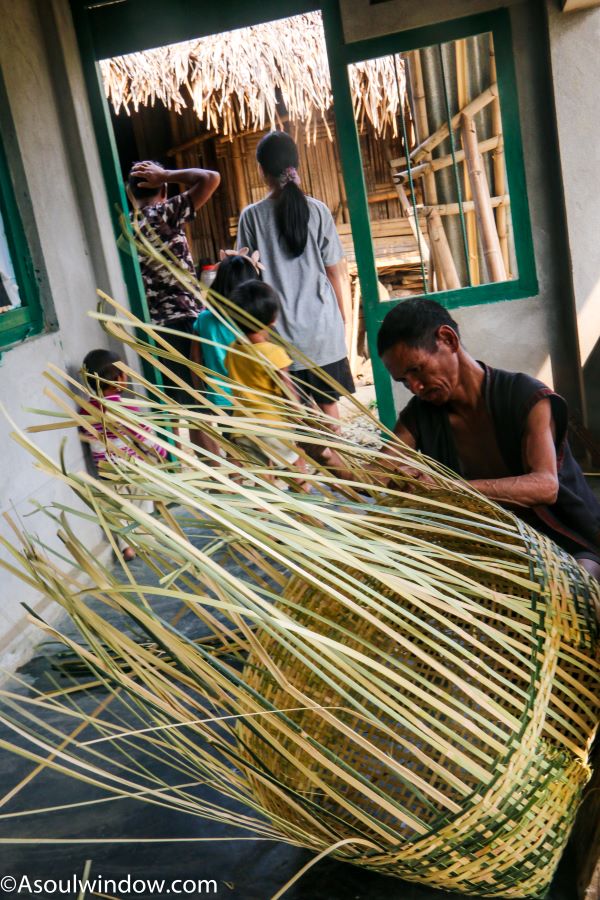
How to reach villages of Nocte Tribe?
Nocte people reside in the Northeastern Indian state of Arunachal Pradesh. If you are keen to be a part of the Nocte homeland trails, you may contact with a local tour operator.
India Myanmar International Borders
The Patkai hills is a distinct geographical region which sometimes also fall in the territory of Myanmar as well. Interestingly, there has never been any restrictions in the free movement between the residents of Myanmar and India in this part of the world. The native people on either side have been freely moving in to each other’s territories since centuries.
When I visited Lazu village near Khonsa, a local man told me how people from Myanmar keep visiting Lazu for trade, shopping etc. Many people from Myanmar also have relatives in Lazo. So, they come here to meet them and vice the versa. Many Indians also go to Myanmar side for same purpose. There is a lot of cultural exchange that keeps happening between Myanmar and India. Lazo is located merely 7-8 kilometers from the border between India and Myanmar. Inter marriages between the people of Myanmar and India is also very common.
Longding and Tirap Itinerary
Here is the original itinerary we were supposed to follow. We took a little liberty and made the itinerary even more exciting.
Day 1: Arrived in Itanagar
Day 2: Itanagar to Longding (Wancho tribe)
Day 3: Longding to Konsa village. Enroute, we visited Pongchau village. We spent the night at Longding
Day 4: Longding to Longkhaw village. Later drive to Wakka. We stayed overnight in a homestay in Wakka. (We skipped Longkhaw and visited Nyinu and Ngissa)
Day 5: Wakka to Khonsa enroute visit Luthong & Lapnan (Nocte Tribe). We instead attended Oriah festival in Chasa.
Day 6: Khonsa to Lazu & Noglo enroute visit Kheti village. (Ollo Nocte tribe)
Day 7: Visit Laho & Moktowa village (Upper Nocte)
Day 8: Khonsa to Dibrugarh drop and the tour ends. There is so much to see here that we also visited Hangpan Dada memorial, Hukanjuri check post, a Thai Buddhist village and Namphake Buddhist Monastery and tea garden while returning to Assam.
Day 9: I took a flight from Dibrugarh airport which is located close to Arunachal Bhawan of Dibrugarh where I stayed overnight.

Conclusion
Transition is an indispensable part of tradition. Throughout history, I have observed that every tradition undergoes transition and massive transformation. These changes do not belong to just one era, but is constant. Needless to say, Noctes have also undergone transition since centuries and are still evolving. The distinct marks of transition are easily visible on the Nocte culture as they gave up headhunting, embraced Christianity and started living in cemented homes and wearing western outfits. Many have even left homes and settled in bigger cities such as Mumbai, Bengaluru, Delhi, Itanagar or Khonsa.
I could easily see the influence of foreign culture on the lifestyle of Noctes. I noticed that most of the common people in Nocte villages have abandoned many of their age-old customs. On the other hand, the original dresses, artefacts, handicrafts and traditional ornaments can still now can be in the royal homes of various villages. Nocte headhunting history is full of interesting stories. You can also learn about the Noctes, the head-hunting tribes of Arunachal Pradesh by visiting Tirap and Longding districts.
Related Blogs
Wancho Tribes of Arunachal Pradesh
Stay in Dirang Boutique Cottages
Plan a trip to Arunachal Pradesh
North East India packaged tour review
Best places to see in Itanagar
Top Travel Blogger from India

Glad to know that foreigners are showing interest in learning about the Nocte tribe. North-east India is highly unexplored by foreigners. I hope the infrastructure gets good enough soon for people from around the world to visit the region.
After reading this article, even I am eager to explore this region and tribe.
True Anukruti. There is so much to explore in North East India that I can spend the rest of my life studying and documenting various aspects of it.
Count me in, please. I mean if you need any assistance 🙂 The region is just so fascinating.
Yes, so much yet to discover in Arunachal Pradesh!
Very informative and detailed blog. Thanks for sharing lesser known aspects of the tribes! Kudos for documenting this remote part of the country!
Thank you for the lovely comment and encouragement! I want to document more tribes of North East India now. This trip was such a great learning experience.